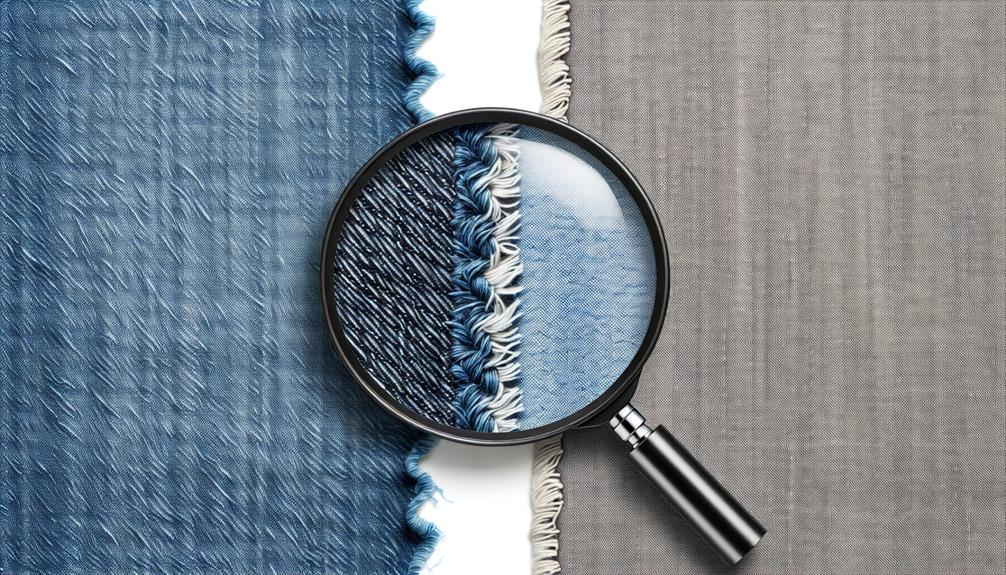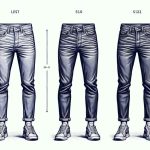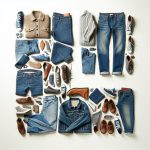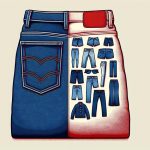I've been noticing a lot of chatter about fake denim lately, and it's got me thinking. With brands like Levi's and Calvin Klein being mimicked by counterfeiters, it's becoming tough to tell what's real and what's not. This whole situation is affecting not just the fashion economy but also how we view the authenticity of our clothes. I'm curious about how deep this goes and what it means for us as consumers. How do we spot the fakes, and what can we do to ensure we're getting the real deal? Let's dive into this together and see what's really behind the label.
Table of Contents
Key Takeaways
- Yes, the market has seen a rise in counterfeit denim, affecting major brands like Levi's and Calvin Klein.
- Fake denim often skimps on quality, using inferior materials and craftsmanship compared to genuine denim.
- Counterfeit denim damages brand reputations and undermines consumer trust in the market.
- Consumers can identify fake denim by checking for poor fabric quality, incorrect logos, and spelling errors on labels.
- Purchasing from authorized retailers or brand websites is recommended to avoid counterfeit denim.
The Rise of Counterfeit Denim
With big names like Levi's and Calvin Klein, it's no surprise that fake denim's on the rise. The allure of snagging these iconic brands at a fraction of the price is tempting, I get it. But here's the rub: these knock-offs are flooding the market, undercutting the real deal and fooling consumers left and right. It's not just about wearing a label; it's about quality, sustainability, and supporting legit business practices.
When you think you've scored Authentic Levis jeans for less, chances are, if the deal seems too good to be true, it probably is. These fakes aren't just a hit or miss on style; they're often made of subpar materials that won't last, leaving you out of pocket and back at square one. The impact goes beyond just disappointment. The rise of fake denim hurts the economy and tarnishes the reputation of brands we've grown to trust.
Identifying Fake Denim Brands
Understanding how to spot fake denim brands can save you from getting duped by knock-offs. You've probably seen those jeans that look almost too good to be true, and that's because often, they are. Fake denim brands are notorious for imitating the big names but skimp on quality and craftsmanship. It's not just about saving a few bucks; it's about knowing what you're getting into.
Here's the deal: genuine denim comes with a level of quality that fake ones can't match. Authentic brands pride themselves on using high-quality materials and ensuring every stitch is in place. When you're eyeing that pair of jeans, check for any obvious errors. These mistakes are telltale signs that you're looking at a counterfeit.
Another pointer is durability. Authentic denim feels sturdy and lasts ages, while knock-offs might start falling apart after a few washes. Remember, in countries where trends trump authenticity, fakes are more common. But don't let that sway you. Spotting fake denim is about paying attention to the details and understanding that real quality stands the test of time.
Quality Differences Between Real and Fake
Diving into the quality differences between real and fake denim, it's clear that the genuine stuff beats the knock-offs every time. When you're investing in a pair of jeans, you're not just buying fabric; you're investing in craftsmanship, durability, and, let's be honest, a bit of prestige. Real denim, with its high-quality materials and meticulous attention to detail, is in a league of its own.
Here's a quick breakdown to highlight the stark differences:
| Feature | Real Denim | Fake Denim |
|---|---|---|
| Stitching | Precise and symmetrical | Frayed or uneven |
| Materials | High quality for durability | Inferior, less durable |
| Branding | Accurate logos and labels | Poorly imitated |
| Craftsmanship | Invested in quality control | Lacks consistency |
| Coloring | Even and resistant to fading | Prone to fading, errors |
Back to basics, if you're aiming for mastery in your denim game, remember that genuine denim pays off. Not only does it look and feel better, but it also stands the test of time. So, don't be fooled by the allure of a cheaper price tag. The truth is, investing in high-quality denim means investing in your style, comfort, and ultimately, yourself.
Tips for Authentic Denim Shopping
I've got to say, shopping for authentic denim can be tricky, but I've picked up a few tips that really help.
First off, knowing how to spot the signs of genuine denim, like the weave patterns, makes a huge difference.
Also, understanding that higher quality usually comes with a higher price tag has saved me from falling for fakes.
Spotting Genuine Denim Signs
When shopping for genuine denim, it's crucial to look out for symmetrical and non-frayed stitching as a hallmark of quality. You won't find that precision in fake Levis. Another tip? Check for the style number stamped onto the front of the jeans. This is a dead giveaway. If the brand names are misspelled, that's a major red flag.
Authentic denim fades gracefully after washes, a sign of superior material. Trust your gut when something feels off; it probably is. Remember, real denim is built to last with durable materials. If the jeans feel flimsy or too lightweight, question its authenticity.
Spotting genuine denim means paying attention to these details. It's about quality, not just a label.
Understanding Denim Weave Patterns
To spot real denim, it's key to understand the different weave patterns like twill, satin, or broken twill. Twill's what you'll mostly find, with those diagonal lines giving denim its classic look.
Satin weave? That's smoother, kinda luxe feeling. Broken twill mixes it up, changing the diagonal's direction for a distinct texture. Peeping these patterns helps me spot the legit stuff.
I mean, if I'm hunting for genuine Levi Strauss, I'm not just checking the back pocket for that iconic tag. I'm feeling the fabric, eyeing that weave. And the care label? That's my go-to for the lowdown on what I'm really buying.
It's all about getting hands-on to ensure I'm not getting duped by some knock-off.
Price Vs. Quality Analysis
Navigating the tricky waters of denim shopping, it's clear that you get what you pay for, with pricier jeans often signaling better quality. Original denim, with its high-quality materials, is definitely worth the splurge if you're after durability. You'll notice the difference in how long they last.
Knock-offs might tempt you with their low prices, but remember, they're not built to stand the test of time. A telltale sign of real vs. fake? Often, it's all about what's stamped onto the back. Genuine brands pride themselves on craftsmanship and this detail at the back of the top usually showcases their mark of authenticity.
The Impact of Fake Denim on the Industry
Fake denim's impact on the industry is significant, damaging brand reputations and eating into genuine profits. Imagine you've got your eye on a pair of Levis jeans, only to find out they're a fake pair. It's more than just a bummer; it's a blow to the trust we put in brands. These knock-offs, with their telltale signs of cheap fabric and sloppy stitching, aren't just a minor nuisance. They're part of a bigger problem that's undermining consumer trust on a massive scale.
When folks accidentally buy these low-quality imposters, it's not just their look that suffers. Their perception of what quality denim should feel like takes a hit, too. And it's not just about the disappointed customers. The real deal brands end up facing legal battles to protect their names, further chipping away at their bottom line. Educating consumers about the real vs. the fake is crucial. It's not just about saving them from a fashion faux pas; it's about preserving the integrity of the denim industry. We've got to know what we're buying to keep the industry we love strong and authentic.
Protecting Yourself From Scams
After learning how counterfeit denim can impact the industry and our trust in brands, let's talk about how you can steer clear of these scams. I've come to realize that protecting yourself from counterfeit jeans, especially when eyeing those vintage Levis, is all about knowing what to look for and where to look.
Here's a quick guide I put together:
| Tip | Why It Matters |
|---|---|
| Check the top button | The top button often has brand-specific details hard for counterfeiters to replicate perfectly. |
| Research common fake indicators | Knowing what separates the real deal from fakes, like stitching patterns, can save you from scams. |
| Read online reviews | Reviews can reveal a lot about the seller's credibility and the authenticity of their products. |
| Trust your instincts | If a deal seems too good to be true, it probably is. Don't let a low price fool you into buying fake denim. |
I've found that doing a bit of homework and keeping these pointers in mind has saved me from getting duped into buying counterfeit jeans. It's all about staying informed and cautious.
Frequently Asked Questions
Is There Such Thing as Fake Denim?
Yes, there's definitely fake denim out there. It's often made with lower quality materials and might look off, like weird stitching or wrong brand names. I always check carefully before buying to avoid it.
How Do You Know if Jeans Are Original?
To spot original jeans, I check for high-quality materials, symmetrical stitching, slow-fading colors, correct brand spelling, and overall craftsmanship. If something feels off, it's likely not genuine. Trusting my instincts is key.
How Do You Identify Denim Jeans?
To identify denim jeans, I check the stitching, material quality, and brand name spelling. I also pay attention to the overall craftsmanship, making sure it's durable and matches what I know about the brand.
Does Levi Use Real Denim?
Yes, Levi's uses real denim in their jeans, including classic styles made from 100% cotton. Some variations contain a bit of polyester for stretch, but it's all about quality and durability with them.
- Tetron Fabric for Marine Applications: Durability and Use Cases - June 18, 2025
- Tetron Fabric for Outdoor Furniture: Weather Resistance and Care - June 18, 2025
- Tetron Fabric for Wall Coverings: Style and Application Tips - June 18, 2025







